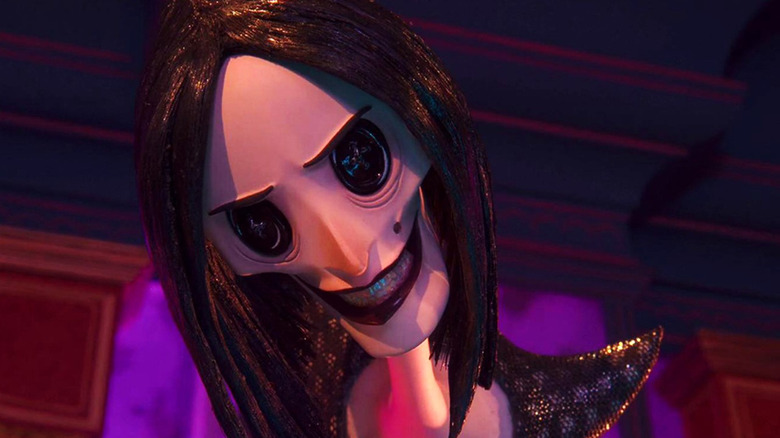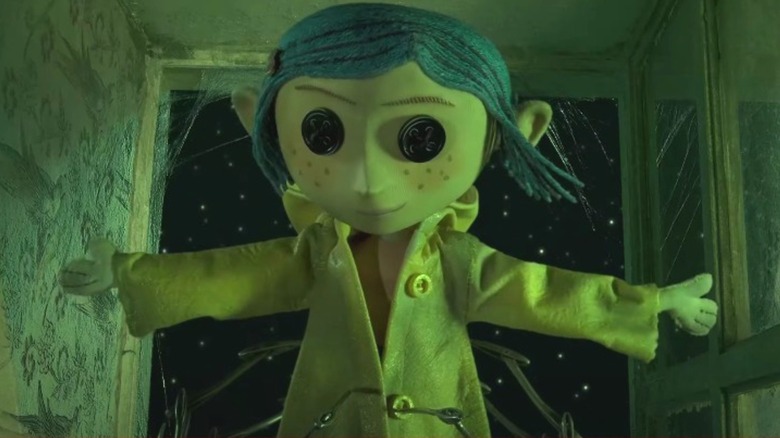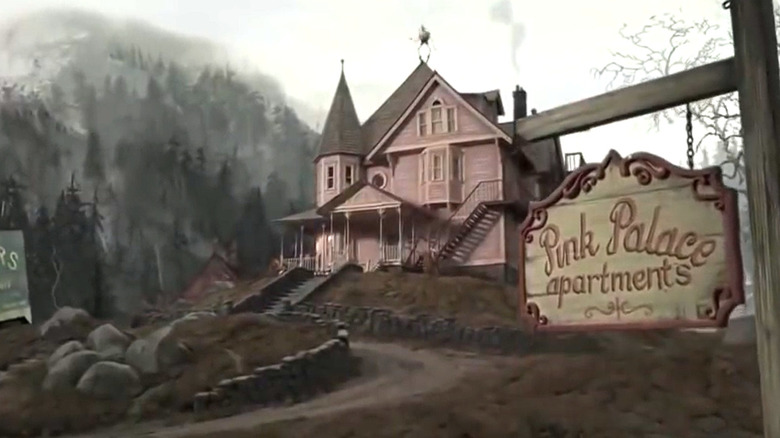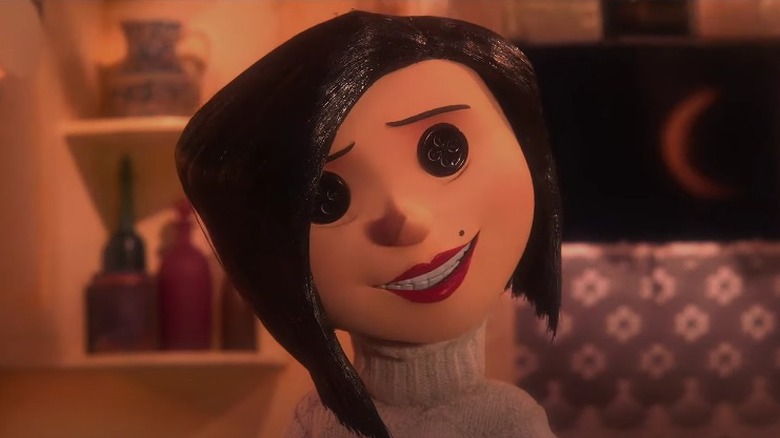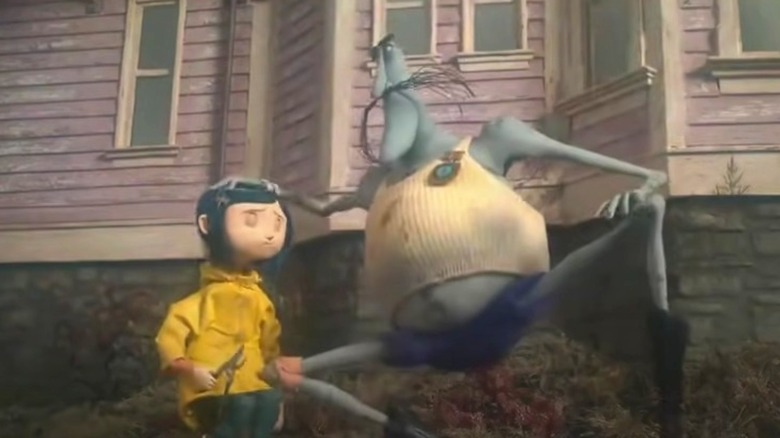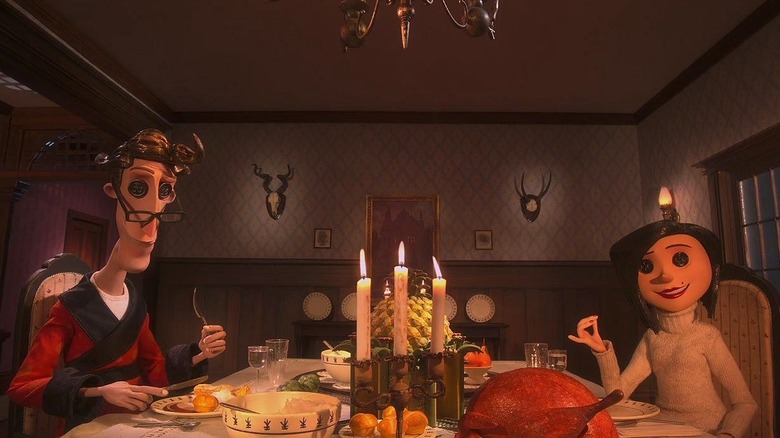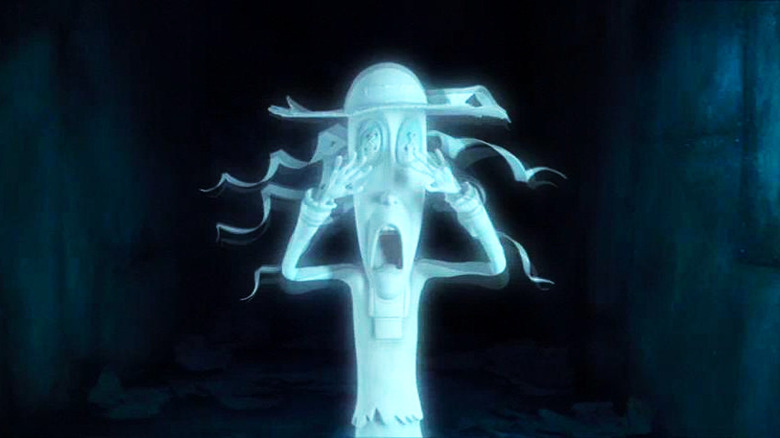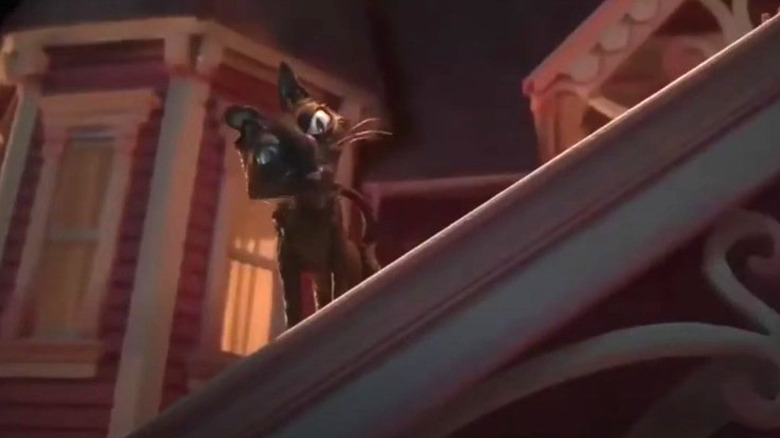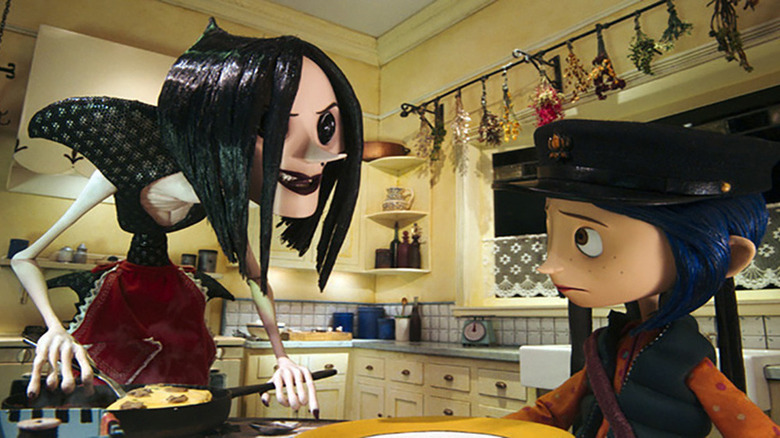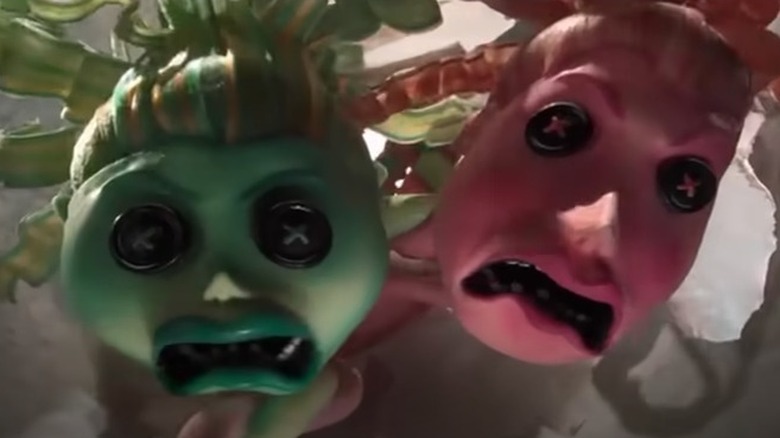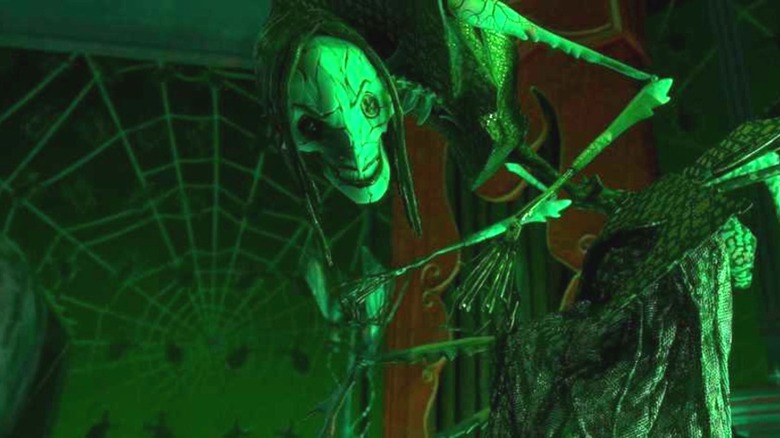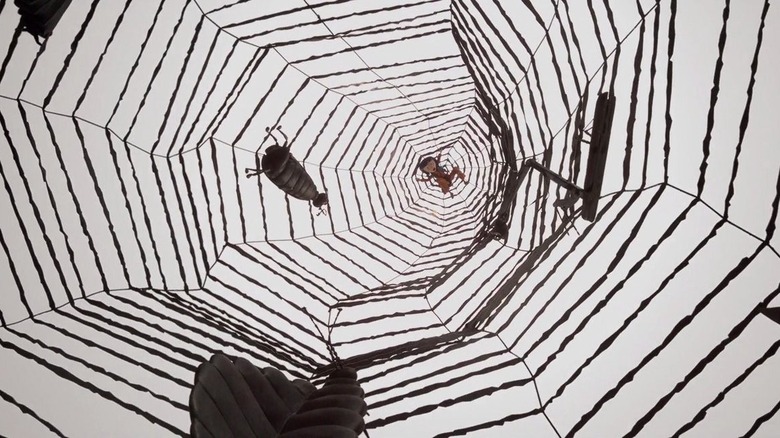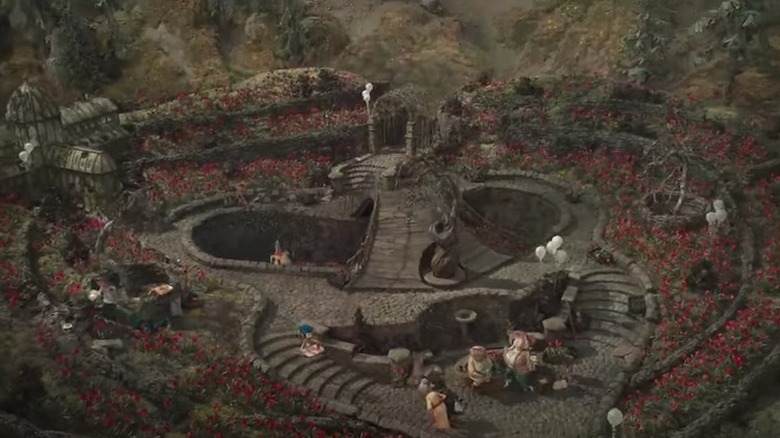The Ending Of Coraline Explained
"Coraline," the 2009 stop motion animated film directed by Henry Selick and based on the novella by Neil Gaiman, tells the story of a young girl (voiced by Dakota Fanning) who escapes her drab and mundane world via a portal in the wall of her apartment. She finds herself in a magical duplicate of her new home, where she is tended to by a woman who looks and sounds just like her mother, but has buttons for eyes and refers to herself as Coraline's Other Mother. While the film certainly earns its PG rating (it's a little scary for very young kids), it can be enjoyed by most families — children will likely identify with the spunky protagonist who has to use her wits to escape danger, while their guardians can marvel at the staggering amount of technical ability and artistry that went into crafting such a lush and engaging film.
The ending of "Coraline," however, has a lot going on in terms of plot and visuals. It's easy to get lost trying to focus on both the details of the story and the spectacle on screen. We're here to explain some of the events and themes of the film to make sure that the next time you watch it, you're able to sit back and enjoy the masterpiece.
Old and new again
The first thing we see in "Coraline" is a doll floating through a window. Mechanical hands strip the doll of its filling and turn it inside out. Although we're watching a skilled craftsperson make an old doll new again, it looks more like an autopsy. With medical precision, the stitches are removed and the insides removed. As new stuffing replaces the old, and the doll's face is repainted, life enters the object.
Later in the film, we learn that these are the withered hands of a tired, old creature who has been wasting away in solitude. The doll is a tool the creature utilizes in order to spy on its potential victim. Through some kind of magic, those black button eyes see the world of the intended target and report back to their master. This information is then used to build a world that the victim would love.
The intention of this creature (referred to later as the Beldam) is to lure young children into her web, rob them of their humanity, and slowly drain them of their life force over time. As we'll see in the very next scene, the Beldam's new target is Coraline, who looks almost exactly like that doll.
The gloom and isolation of the Pink Palace
The story takes place in the Pink Palace, a house that has seemingly been converted into apartments — Coraline and her family have just moved in. Living in the apartment above them is Mr. Bobinsky (Ian McShane), an eccentric Russian man who is training mice for the circus. In the basement apartment are retired actresses Miss Spink (Jennifer Saunders) and Miss Forcible (Dawn French) who surround themselves with mementos from their glory days, and with dogs, both living and stuffed.
Despite the relative brightness of the building's paint, the ground around it is muted, muddy, and almost dead. It's as though something has been slowly draining the life out of it over time. When Coraline's hum-drum father (John Hodgman) suggests Coraline explore the house, all her explorations reveal is the rot of its framework and the overabundance of bugs crawling out of dark places. All evidence suggests that this is a dying place.
Surrounded by all this gloom, with her yellow jacket and blue hair, Coraline is the only vibrant splash of color in the whole place. She stands out against these drab backgrounds — both to us, the audience, and to the secret, ancient thing hidden within the Pink Palace's depths.
Coraline's search for home
Coraline doesn't fit in. She's an outcast in nearly every scene. At the start of the film, she has just been uprooted from her home and forced to relocate to the gloomy and desolate Pink Palace apartments. Here, she has no friends, and her parents are too busy to focus on anything other than work. Not only is she frequently ignored by them, but they also have no interest in making their new residence a home, contributing to her sense of displacement. Coraline is left yearning for love, affection, and excitement. She sees the potential in the Pink Palace and its enormous garden, but lacks the emotional support to turn it into her home.
Coraline eventually meets a feral cat and a boy named Wybie while looking for a well with her dowsing rod. Both could be her friends, but she's too upset and guarded to let anyone get close to her, and this loneliness is exploitable. The Beldam sees Coraline's suffering and calls to her, using the doll (which is given to Coraline by Wybie) to guide her to a secret door in her house. It's been papered over and opens onto a brick wall, but at night, it's a gateway to the world of her dreams — and a trap to keep her there for a very, very long time.
Beware of dreams coming true
Coraline's mother (Teri Hatcher) isn't a bad person or even a bad mother, she is merely distracted. As she and her husband struggle to finish their latest project, Coraline is left to entertain herself. Her mom doesn't really cook and the food they do eat is unappealing. Both parents write about gardens but have no interest in working outdoors themselves. It isn't difficult to see why Coraline would dream of something more.
The portal in the wall leads to the Other apartment. It's exactly like hers, but warmer, more welcoming. She meets someone calling herself Coraline's Other Mother, and her Other Father is there, too. Both are affectionate, attentive, and exciting. They actually seem to like having Coraline around. The food they prepare is delicious and the garden is bursting with life.
At first, it's suggested that this is a dream. While it's certainly true that this is a manifestation of Coraline's dream for a better life, the Other World does actually exist, built by the Beldam's magic to ensnare Coraline, like a spider weaving its web to attract insects — only to trap them and feed.
Shifting your focus
You can't really blame Coraline for not appreciating what she has. Her parents seem to have no interest in her, and the other residents of the Pink Palace don't even call her by her actual name — everyone is convinced that her name is Caroline. Her Other Mother and Father, however, never hesitate to use her correct name.
Mr. Bobinsky's mice also know that her name is Coraline, which is a source of amusement for Bobinsky. Through him, the mice deliver a warning, telling her not to go through the little door. Spink and Forcible also warn Coraline that she is in danger. Coraline doesn't listen to these strange characters, however. Why should she care what they have to say? They don't even know her name.
That is what's so brilliant about the Beldam's snare. The creature knows all the ways in which Coraline is unhappy and has built a world so shiny and appealing that it distracts her from the truth. If Coraline had listened to the various warnings and appreciated Wybie's misguided attempt at being friends, the Beldam might never have stood a chance at stealing Coraline's humanity.
Soon you'll see things our way
After a few visits to the Other apartment, Coraline's Other Mother is confident that she's convinced her "daughter" to devote herself to this dream world. She's able to provide Coraline with everything she could ask for — even a silent Wybie who isn't so annoying. Why wouldn't the girl want to spend the rest of her life with her in this kingdom of love and comfort?
When offering Coraline the choice of staying, the Other Mother explains that the only way to do so is to replace her eyes with buttons. If Coraline does this, she will effectively be handing over her humanity, allowing the Beldam to keep her as a prisoner. Not that Coraline knows that, of course, but she still refuses, horrified at the idea of sewing buttons into her eyes. Her choice throws the Other Mother for a loop. This is the beginning of the end for the Beldam.
From here on out, the creature's tactics become more desperate and the facade of her magic begins to wear off. With each subsequent scene, we witness the illusion of the Other apartment fall away and the Other Mother's true, terrifying nature is revealed. It's also the thing that gives Coraline the drive she needs to spring into action and end this deception once and for all.
The Beldam's dark history
When Wybie gives Coraline the doll he found in his grandmother's belongings, he does so as a peace offering for having annoyed her. He says that the doll is very old and doesn't know why it looks like Coraline. We also learn that his grandmother, who owns the Pink Palace, believes the place is evil, as her sister went missing from the house when they were kids.
The doll had previously belonged to the missing sister, and Coraline meets her ghost in a dark room where the Other Mother has trapped her. There are two other ghosts there, as well. All three were tricked like Coraline. They explain that the Other Mother is the Beldam, and that she uses the doll as spy. They fell for her illusions so completely that they allowed her to take their eyes and feed off them for years.
The ghosts' real eyes hold their souls within them. If someone finds the eyes, then their souls can go free. Although her primary intention is to escape, Coraline can't let those ghosts remain trapped for eternity. When she finally decides to take on the Beldam head-on, she makes sure to try and free the ghosts, as well. To do this, she is going to have to take some hints from the real world to view the Beldam's false world for the lie that it is.
Games and the edges of reality
Just like the Pink Palace, the cat Coraline meets earlier in the film (voiced by the legendary Keith David) has more to him than meets the eye. When he follows her through the portal to the Other apartment, we learn that he is able to speak. Not only that, but he comes here quite often, knowing that his ability to come and go as he pleases annoys the Beldam. It's a little game they play.
He and Coraline walk to the edge of the Other World and back again in a matter of minutes. Beyond the garden and trees, there is nothing but white oblivion. While the real world may look gloomy and depressing, at least there are possibilities out there. Here, there is only what the Beldam has made for Coraline, further proving that even this is magical, wonderful place is still confinement.
The cat's experience has taught him that the Beldam likes games. She doesn't play by the rules, but she can't refuse a challenge. So when Coraline's parents are taken and trapped somewhere in the Other apartment as a means of bringing Coraline back, the cat suggests she challenge the Beldam to a game — if Coraline can find her parents and the souls of the ghost children, they all go free. If she can't, Coraline herself will stay forever.
Seeing the truth
Perception is a major motif in "Coraline." We've already discussed the ways in which the Beldam's powers are obscuring the truth and how Coraline needs to appreciate the real world a bit more, but it goes even further than that. The ghost children were unable to see beyond the Beldam's magic, and their eyes were taken away. Bobinsky, Spink, and Forcible were too lost in their own delusions to see the anguish Coraline was experiencing. Her own parents were so concerned with work that they missed their chance to save their daughter.
It's only when Coraline is able to see things for how they truly are that she's able to defeat the Beldam. She does this in two ways. The first is with a kind of seeing stone fashioned for her out of old candy. When looking through it, she is able to spot the weak spots in the Beldam's magic. This allows her to find the missing eyes of the ghost children hidden in plain sight.
Second, when Coraline's parents are taken, they send her a message through a mirror saying they need her help. Coraline sees that they're trapped somewhere cold, but isn't positive where that is. Driven by her need to rescue her parents, however, Coraline is more perceptive than ever. She isn't allowing the Beldam's tricks to distract her — she is questioning everything. By observing her surroundings rather than marveling at them, she can more effectively navigate the world of the Other apartment.
When dreams turn on you
The ghosts' eyes are hidden in three locations: the garden in the shape of Coraline's face, the apartment of the Other Spink and Forcible, and the Other Bobinsky's apartment. At each location, Coraline is attacked. The magnificent creatures of the garden spring to life, trying to keep Coraline away from the first eye. Spink and Forcible cling to Coraline's wrist, demanding to keep the second eye. Bobinsky's amazing mice keep the third eye out of Coraline's reach.
Her utopia has become a nightmare. The Beldam's magic is waning, and she is lashing out by turning the very things that first charmed Coraline into monsters. If it wasn't for Coraline's connection with her Other Father, she may not have succeeded in the garden. If she were less clever, she never would've thought about waking up the sleeping bat-dogs that attack the Other Spink and Forcible. Had she not given the cat a chance, he may not have been there to stop the Other Bobinsky's mice.
This is Coraline's moment to use what she has learned to defeat the magic that kept her in the dark. The Beldam's mastery of deceit is no match for Coraline's quick thinking, and more importantly, her friendships.
You know I love you
Once Coraline has found the eyes, every shred of the Other Mother's human form falls away. Her true form resembles a spindly bug with wire claws, like an unfinished stop motion puppet, or a spider. This reveal makes it clear that it was her hands we saw reforging the doll during the opening credits. She destroys Coraline's vision stone, making it that much harder for Coraline to find her parents.
One of the ghost children tells Coraline she needs to be clever in order to win. We've seen her ingenuity at work before, and now it is her sole weapon against the deadly Beldam. She tricks the Other Mother into opening the door leading back to the real world by saying she knows that's where her parents are hidden. As the door is being opened, the cat and Coraline see that her parents are actually trapped within a snow globe from the Detroit Zoo.
Coraline throws the cat into the Beldam's face. He claws out her button eyes and Coraline drops the snow globe into her bag, winning the game.
The spider and the fly
Enraged at having lost, the Beldam abandons any pretense. She takes her final form and the house itself is reduced to a funnel-shaped spider's web. A few bugs have already been trapped there, explaining the house's insectoid furniture. This scene is one big visual metaphor for the fact that the Beldam has been weaving a web of magic to create this world and trap Coraline.
Coraline climbs to freedom. As she passes through the door, the Beldam grabs her. The ghost children reach out and help her pull the door closed (repaying her kindness) but one of the Beldam's hands is severed. Coraline rushes back to her apartment as the portal starts to close and the Beldam wails. Coraline makes it back to the house, and slams and locks the door.
Her parents have been freed. They have no memory of what happened and don't seem concerned about being covered in water and snow. Coraline goes to bed, happy to have her real parents back. She also apologizes to the cat for using him as a weapon. Together, they free the ghost children by falling asleep, because some part of all this is fueled by Coraline's imagination.
Coraline has learned the importance of selflessness. She's been too focused on what she wants. Now that she is actively pursuing more altruistic goals, the darkness around her is fading.
There's only one key
In order to ensure that the Beldam never tries to get to her again, Coraline has to get rid of the key to the Other World. She does this by tossing it down a very deep well, after Wybie helps her fight off the Beldam's severed arm. By getting rid of the key, Coraline is throwing away the false belief that the world around her isn't good enough. She is now free to engage with the real world and turn it into something beautiful.
Sometime later, the gloom has lifted from the area. The residents of the Pink Palace are all working together to replant the garden and bring life back into this place. Everyone seems happy and excited for the future, rather than living in the past. Even Wybie and his grandmother have come for a visit. Coraline has overcome her loneliness and embraced her surroundings and the people around her, and for now, everyone is living happily ever after.
